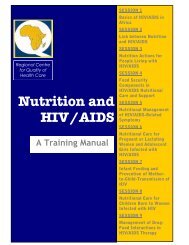2.1: Anthropometric Indicators Measurement Guide - Linkages Project
2.1: Anthropometric Indicators Measurement Guide - Linkages Project
2.1: Anthropometric Indicators Measurement Guide - Linkages Project
You also want an ePaper? Increase the reach of your titles
YUMPU automatically turns print PDFs into web optimized ePapers that Google loves.
Example 2<br />
A Cooperating Sponsor conducted a baseline and final-year survey collecting height and weight data on 24-59<br />
month old children. At both times the sample was randomly drawn from the target communities and did not include<br />
the same children in both surveys. The pre-post design enabled a comparison of change in nutritional status (as<br />
reflected by height-for-age) in the target communities.<br />
Baseline at time zero:<br />
(t 0 ): Mean Z-score = -2.05 (sd=1.26); Prevalence (-2SD cut-off) = 40%<br />
Sample size = 940<br />
Final year at time five:<br />
(t 5 ): Mean Z-score = -1.20 (sd=1.15); Prevalence (-2SD cut-off) = 23%<br />
Sample size = 1056<br />
Using statistical software to conduct the t-test (e.g. SPSS, or STATA; note that Epi Info 2000 or Epi Info 6 does not<br />
have this test), the testing of the significance of the change in the sample means is straightforward.<br />
t = (Mean t 0 - Mean t 5 ) / sq. root (Variance t 0 /n 0 + variance t 5 /n 5 )<br />
where n 0 and n 5 is sample size at baseline and final year.<br />
t = (-2.05 - (-1.20)) / [sq. root ((1.26x1.26)/940)) + ((1.15x1.15)/1056))]<br />
t = (-0.85) /[sq. root (0.0016889) + (0.0012523)]<br />
t = (-0.85) /[ 0.054233]<br />
t = 15.67<br />
This change in mean Z-scores is highly significant (i.e. well above the critical t-value of 1.96 at 0.05 level).<br />
7.4.Additional Data Analysis Information<br />
7.<br />
In cooperation with Food Aid Management,<br />
FANTA developed a workshop for the<br />
training of program managers in the<br />
calculation and analysis of basic<br />
anthropometric data using Epi Info and<br />
SPSS. The materials from the Data Analysis<br />
Workshop are available at:<br />
www.fantaproject.org/focus/index under<br />
Monitoring and Evaluation.<br />
Step by step instructions on data analysis<br />
can be found on the Practical Analysis of<br />
Nutritional Data (PANDA) website:<br />
www.tulane.edu/~panda2/. PANDA was<br />
designed for data analysis instruction using<br />
SPSS software.<br />
There are many statistical analysis software<br />
packages available, other than Epi Info. The<br />
packages listed below are only a few of the<br />
commonly used statistical analysis software<br />
programs. These packages vary in<br />
capability and cost. Information on<br />
capability and ordering the packages can be<br />
found on their web sites.<br />
SPSS (Statistical Package for Social<br />
Sciences) www.spss.com<br />
SAS (Statistical Analysis System)<br />
www.sas.com<br />
STATA (Statistics/Data Analysis)<br />
www.stata.com<br />
SUDAAN (Software for the Statistical<br />
Analysis of Correlated Data)<br />
www.rti.org/patents/sudaan/sudaan.html<br />
48

















